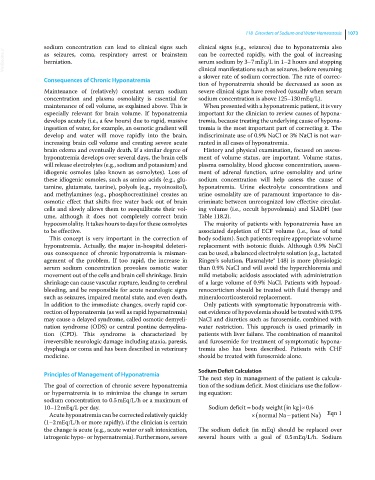Page 1135 - Clinical Small Animal Internal Medicine
P. 1135
118 Disorders of Sodium and Water Homeostasis 1073
sodium concentration can lead to clinical signs such clinical signs (e.g., seizures) due to hyponatremia also
VetBooks.ir as seizures, coma, respiratory arrest or brainstem can be corrected rapidly, with the goal of increasing
serum sodium by 3–7 mEq/L in 1–2 hours and stopping
herniation.
clinical manifestations such as seizures, before resuming
a slower rate of sodium correction. The rate of correc-
Consequences of Chronic Hyponatremia
tion of hyponatremia should be decreased as soon as
Maintenance of (relatively) constant serum sodium severe clinical signs have resolved (usually when serum
concentration and plasma osmolality is essential for sodium concentration is above 125–130 mEq/L).
maintenance of cell volume, as explained above. This is When presented with a hyponatremic patient, it is very
especially relevant for brain volume. If hyponatremia important for the clinician to review causes of hypona-
develops acutely (i.e., a few hours) due to rapid, massive tremia, because treating the underlying cause of hypona-
ingestion of water, for example, an osmotic gradient will tremia is the most important part of correcting it. The
develop and water will move rapidly into the brain, indiscriminate use of 0.9% NaCl or 3% NaCl is not war-
increasing brain cell volume and creating severe acute ranted in all cases of hyponatremia.
brain edema and eventually death. If a similar degree of History and physical examination, focused on assess-
hyponatremia develops over several days, the brain cells ment of volume status, are important. Volume status,
will release electrolytes (e.g., sodium and potassium) and plasma osmolality, blood glucose concentration, assess-
idiogenic osmoles (also known as osmolytes). Loss of ment of adrenal function, urine osmolality and urine
these idiogenic osmoles, such as amino acids (e.g., glu- sodium concentration will help assess the cause of
tamine, glutamate, taurine), polyols (e.g., myoinositol), hyponatremia. Urine electrolyte concentrations and
and methylamines (e.g., phosphocreatinine) creates an urine osmolality are of paramount importance to dis-
osmotic effect that shifts free water back out of brain criminate between unrecognized low effective circulat-
cells and slowly allows them to reequilibrate their vol- ing volume (i.e., occult hypovolemia) and SIADH (see
ume, although it does not completely correct brain Table 118.2).
hypoosmolality. It takes hours to days for these osmolytes The majority of patients with hyponatremia have an
to be effective. associated depletion of ECF volume (i.e., loss of total
This concept is very important in the correction of body sodium). Such patients require appropriate volume
hyponatremia. Actually, the major in‐hospital deleteri- replacement with isotonic fluids. Although 0.9% NaCl
ous consequence of chronic hyponatremia is misman- can be used, a balanced electrolyte solution (e.g., lactated
agement of the problem. If too rapid, the increase in Ringer’s solution, Plasmalyte® 148) is more physiologic
serum sodium concentration provokes osmotic water than 0.9% NaCl and will avoid the hyperchloremia and
movement out of the cells and brain cell shrinkage. Brain mild metabolic acidosis associated with administration
shrinkage can cause vascular rupture, leading to cerebral of a large volume of 0.9% NaCl. Patients with hypoad-
bleeding, and be responsible for acute neurologic signs renocorticism should be treated with fluid therapy and
such as seizures, impaired mental state, and even death. mineralocorticosteroid replacement.
In addition to the immediate changes, overly rapid cor- Only patients with symptomatic hyponatremia with-
rection of hyponatremia (as well as rapid hypernatremia) out evidence of hypovolemia should be treated with 0.9%
may cause a delayed syndrome, called osmotic demyeli- NaCl and diuretics such as furosemide, combined with
nation syndrome (ODS) or central pontine demyelina- water restriction. This approach is used primarily in
tion (CPD). This syndrome is characterized by patients with liver failure. The combination of mannitol
irreversible neurologic damage including ataxia, paresis, and furosemide for treatment of symptomatic hypona-
dysphagia or coma and has been described in veterinary tremia also has been described. Patients with CHF
medicine. should be treated with furosemide alone.
Sodium Deficit Calculation
Principles of Management of Hyponatremia
The next step in management of the patient is calcula-
The goal of correction of chronic severe hyponatremia tion of the sodium deficit. Most clinicians use the follow-
or hypernatremia is to minimize the change in serum ing equation:
sodium concentration to 0.5 mEq/L/h or a maximum of
10–12 mEq/L per day. Sodium deficit body weight in kg 06
.
Acute hyponatremia can be corrected relatively quickly normal Napatient Na Eqn 1
(1–2 mEq/L/h or more rapidly), if the clinician is certain
the change is acute (e.g., acute water or salt intoxication, The sodium deficit (in mEq) should be replaced over
iatrogenic hypo‐ or hypernatremia). Furthermore, severe several hours with a goal of 0.5 mEq/L/h. Sodium

